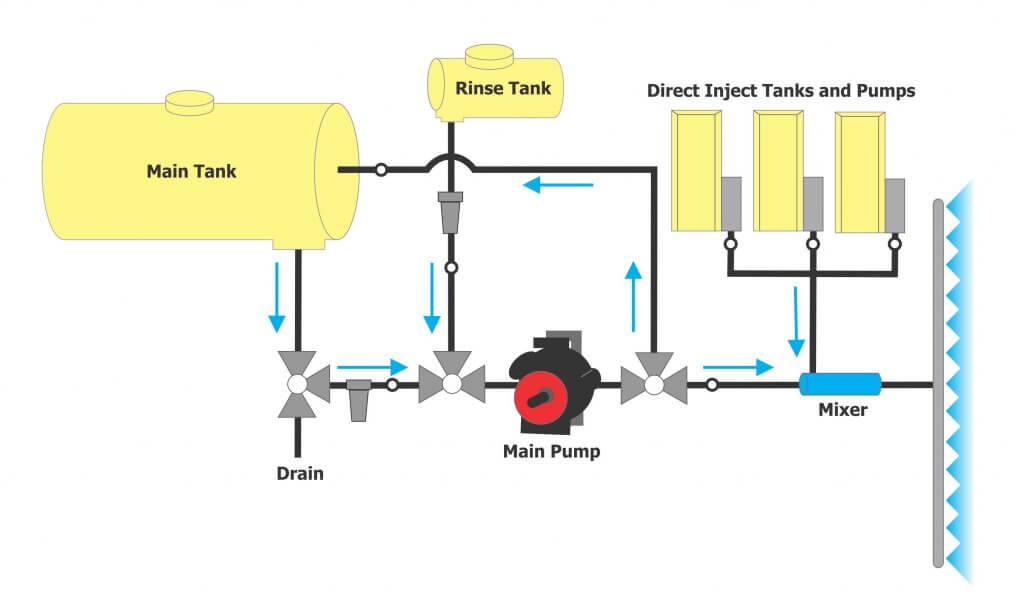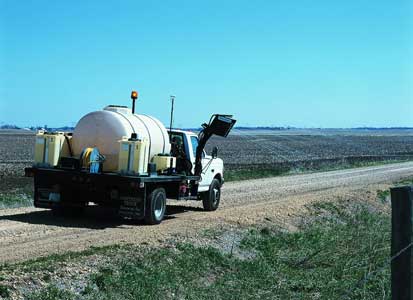No sprayer operator is more preoccupied with work rates, sprayer cleanout and tank mixes than the custom (aka contract) applicator. Perhaps this is why we’re seeing more direct injection systems on their sprayers in recent years.
Injection systems employ additional tanks and pumps to introduce undiluted product directly into the carrier just prior to the boom. They are designed to maintain the product concentration in the boom (they are not for variable rate prescription spraying within in a field). This permits the operator to change tank mixes between fields without having to clean out or refill.

In the 1980’s, Mid-Tech first offered the TASC peristaltic pump injection system. The bulk of this market was (and still is) right-of-way applications (e.g. railways, highways). Unlike a field application, which covers an area, these sprayers cover a linear distance that makes reloading challenging. When the chemistry is carried onboard, water can be easily accessed along the way.

In the 1990’s, field sprayer operators tried using direct injection and encountered problems:
- Spray concentrations would fluctuate because product was injected based on travel speed while the carrier rate was a constant.
- Latency (aka lag) issues were commonplace. Imagine spraying 10 gpa using a boom that holds 15 gallons. A change in speed would prompt a change in injection rate that would not reach the outermost nozzles until half the acre was sprayed.
- And, changes in temperature affected the accuracy of the injection systems, so rates changed as cold mornings gave way to warm afternoons.
But the technology has evolved. Today’s injection systems are more consistent and accurate. Here are a few niche usage scenarios to consider:
Usage scenarios
1. Anhydrous ammonia applications require nitrogen stabilizers. The stabilizers are intended to treat the soil, not the ammonia. An injection system can introduce nitrogen at a rate that matches a field’s soil type, while the ammonia is applied on a per-area rate.
2. *Small plot work, such as seed production, consists of many sub-acre plots requiring a range of doses. Injection systems improve work rate by reducing refills or cleanouts between applications.
3. Where appropriate, border sprays of insecticide can be introduced during herbicide post applications.
4. Applicators can adjust herbicide mixtures and glyphosate rates between fields depending on weed pressure.
5. Custom applicators can adjust glyphosate rates when terminating cover crops. For example, alfalfa is a perennial planted for feed before corn. When it gets hardy and begins dormancy late-season, it requires more glyphosate. Oats are used as a cover following winter wheat, and both oats and volunteer wheat require a much lower dose.
6. Clients of custom application may or may not want foliar fertilizer (e.g. zinc) amendments. This service is only feasible using direct injections systems.
*This scenario was communicated to the author by a company selling the equipment, but subsequently there has been some question as to how this might work. The amount of time and water required to clear lines between applications would depend on the nature of the chemistry and whether it is a rate or wholesale chemistry change. As such, there are situations that would make this an impractical use of the technology.
Today’s injection systems
Mid-Tech/TeeJet
In early 2000, TeeJet acquired Mid-Tech and offers two injection systems that can control up to six 28 L (7.5 gal.) or 95 L (25 gal.) tanks on a single sprayer. The tanks have an optional agitation feature.
The MT-500 peristaltic pump (still predominantly for roadway applications) injects into the suction side of the main pump to facilitate mixing. It delivers 6-10 ml/min. (0.2-350 oz/min.) but flow rate can be changed by changing hoses. Peristaltic hoses lose accuracy as they wear with time, but hose is cheaper to replace than seats on a piston pump. It can run in reverse to pull product back from the lines. It works with the TASC controller.
The MT-600 is a piston-pump with a mixing chamber option that injects the pressure side of the main pump leaving more clean line and increasing response time at the nozzle (i.e. less lag). It must have backflow prevention (typically a seated ball valve). Depending on the rate required, high and low-volume product pumps can be added in pairs to extend the range: 15-1,500 ml/min. (0.5-50 oz/min.), 30-3,000 ml/min. (1-100 gal./min.), 45-4,500 ml/min. (1.5-150 oz/min.) or 60-600 ml/min. (2-200 oz/min.). High and low-volume product pumps can be added in pairs to extend the range. This pump works with TASC controllers and the ISOBUS Legacy 6600 and Aeros 9040.
Raven
The Raven Sidekick Pro replaced their original Sidekick in 2011. It is ISOBUS compatible with many sprayers and their controllers (e.g. Deere’s Greenstar 3, Raven RCM). It controls up to five 90 L (24 gal.) or 190 L (50 gal.) tanks with optional agitation that can be removed like totes. Depending on the rate required, low [0.03-1.2 L/min. (1-40 oz/min.)] and high-volume [0.15-6 L/min. (5-200 oz/min.)] positive displacement product pumps can be used alone or in pairs to extend the range. Product is injected into a length of latticed pipe in-line on the pressure side of the main pump to create a mixing action prior to the boom.
Other entries
In North America, SurePoint sells the Spartan, which claims to support the direct injection of liquid chemical, fertilizer, biological, or other product into the carrier flow stream. It may be intended for towed implements rather than on a self-propelled sprayer. There are also European entries from Danfoil (the Multidose) and Diimotion (prototype PiiXdi), but information is sparse and the last update we found on either was c.2017.
Pump and tank selection
Quite often, direct injection users regret limiting their pump capacity and the number of tanks installed. This limits travel speed and encourages risky practices such as mixing multiple products in a single injection tank.
Direct injection systems should be capable of staying within your target rate and travel speed. You can calculate your pump requirement in oz/min. using the following formula:
[ Boom width (inches) × Typical ground speed (mph) × Product rate (oz/ac) ] ÷ 5940
Summary
So, if you are considering a direct chemical injection system, give some thought to the following pros and cons.
Pros
- Cleanout is faster when the main tank is reserved for water (Although some operators continue to mix in the main tank and use the product tanks to amend the mix).
- Product tanks are filled from bulk, so there are fewer jugs to handle. That reduces waste and operator exposure during loading.
- Work rate is improved by altering tank mixes between fields without cleaning and reloading.
- There is no spray math required during loading and no excess or deficiency at the end of a field.
- There is no concern about a tank mix sitting for long periods during delays.
- There is reduced potential for spills due to accident or malfunction.
- Tracibility is improved; Instead of recording tank mix per acre, record tank mix by field.
Cons
- Expense.
- Rinsing systems, if available, do not clean lines between injection pumps and tanks. Cleaning requires pulling them apart manually.
- Product tank loading can be slow (up to ½ hr to load 50 US gallons with certain loading assemblies).
- Some products are harder to clean out than others and can plug the injection pump if left full of chemical.
- The number and volume of product tanks may not hold a day’s worth of chemicals.
- Viscous or clay-based products prone to settling or separation (e.g. PrimExtra on corn or Boundry on beans) should not be used.
Thanks to Rob Warwick and Markus Redmond (John Deere), Dennis Frey and Jordan Diefenbacher (Clean Field Services), Brian Satorius and Andy Graber (TeeJet Technologies), Nick Michael and Gary Esselink (Raven Applied Technology), Jan Langenakens (AAMS) and Mark Ledebuhr (Application Insight LLC) for informing this article.